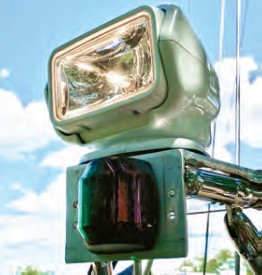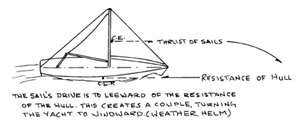A pulpit-mounted spotlight can make all the difference when navigating in the dark.
Issue 136: Jan/Feb 2021
I tend to sneak up on new ideas, so it took me many years of night sailing in the Chesapeake Bay and environs to realize I needed a better way to see in the dark. I was tired of spending a lot of time worrying about snagging crab pots at night, and worse, actually snagging them. And I was tired of not clearly seeing unlit channel daymarks after the sun went down.

The pulpit light on Bucket has worked so well that Roger’s friend added one to her 1986 40-foot Colvic Craft Victor sloop.
Like everyone else, I carried a powerful handheld spotlight aboard my boat, Bucket, a 1972 26-foot British Westerly Chieftain sloop. But when sailing solo and shining the light forward from the cockpit, I often saw only the blinding flashback of light off the rigging and sails. Because yelled communication can be trying, things aren’t much better with crew standing forward with the light. “What? You say starboard? You mean the crab pot is to starboard, or you want me to steer to starboard?”
So, when I rebuilt Bucket years ago for full-time living aboard and cruising, I put age-old sailboat-versus-powerboat prejudices aside and followed the powerboat lead by installing a serious, hard-wired spotlight on Bucket’s bow pulpit, forward of everything.
My spotlight is powerful yet compact. I operate it from the cockpit using a small wireless remote control. I can rotate the light at either of two speeds through large arcs, both horizontal and vertical. The light has performed reliably for years; protecting it from UV with a small canvas cover has likely helped.
This remote-controlled spotlight has revealed crab pots and daymarks, and it has saved my bacon more than once. On one occasion, sailing in the Atlantic off the Delmarva Peninsula, I saw the running lights of a large vessel on a too-close-for-comfort course at least a couple of miles away. I was sailing downwind with a poled-out jib and single-reefed main. It was a clear night with no moon, a fresh breeze, and a moderate sea running. Using information from the AIS, I hailed the vessel on VHF. The captain responded and let me know I was looking at an oceangoing tug without a tow.
I introduced Bucket, explained that I was under sail and that changing course would be difficult, and asked the captain to confirm that he could see me. After a pause, he responded he did not see Bucket, even though my early-generation LED masthead tricolor was on, and I had a radar reflector in the rigging.

Bucket getting prepped for a sail with the bow pulpit light uncovered and ready for use as needed after nightfall.
The tug captain radioed again, asking for my precise coordinates. I quickly answered with our position. After an eternity of about 30 seconds, he replied, “Bucket, I have checked your coordinates, and I have looked again. I still do not see you, visually or on radar.” As the understated British would say, this was a touch alarming.
The captain then added, “Do you have some kind of white light you can turn on so that I can see you?”
“Yes, as a matter of fact I do; stand by.” I frantically dove for the spotlight remote control, switched the light on, and pointed it directly at the tug’s running lights.
“Bucket, I see you now. Hold your course.” As the tug changed course, the captain turned on his spotlight. It was so powerful I swear I could hear it cut through the salt air like a light saber.
I don’t know why I don’t see mounted spotlights on more sailboats. My attitude is that if it only saves me even once, it’s worth it; I don’t care if it is a powerboat idea.
Roger Martin has been sailing since the 1960s. He still owns the 1950s Woodpussy daysailer on which he taught himself how to sail. He’s owned Bucket since 1979. A few years ago, he bought his first powerboat, a trailerable, stitch-and-glue, 17-foot Dipper micro-trawler designed by Sam Devlin.
Thank you to Sailrite Enterprises, Inc., for providing free access to back issues of Good Old Boat through intellectual property rights. Sailrite.com




